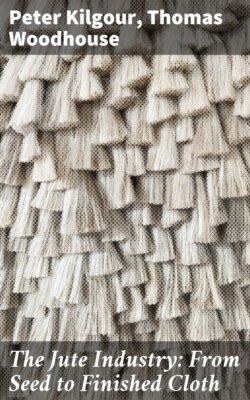Читать книгу The Jute Industry: From Seed to Finished Cloth - Thomas Woodhouse - Страница 8
На сайте Литреса книга снята с продажи.
CHAPTER II. CULTIVATION
ОглавлениеTable of Contents
Botanical and Physical Features of the Plant. Jute fibre is obtained from two varieties of plants which appear to differ only in the shape of the fruit or seed vessel. Thus, the fruit of the variety Corchorus Capsularis is enclosed in a capsule of approximately circular section, whereas the fruit of the variety Corchorus Olitorius is contained in a pod. Both belong to the order Tiliacea, and are annuals cultivated mostly in Bengal and Assam.
Other varieties are recorded, e.g. the Corchorus Japonicus of Japan, and the Corchorus Mompoxensis used in Panama for making a kind of tea, while one variety of jute plant is referred to in the book of job as the Jew's Mallow; this variety C. Olitorius, has been used in the East from time immemorial as a pot herb.
The two main varieties C. Capsularis and C. Olilorius are cultivated in Bengal for the production of fibre, while for seed purposes, large tracts of land are cultivated in Assam, and the seeds exported for use principally in Mymensingh and Dacca.
The above two varieties of the jute plant vary in height from 5 to 15 feet, and, in a normal season, reach maturity in about four months from the time of sowing. In some districts the stems of jute plants are sometimes rather dark in colour, but, in general, they are green or pink, and straight with a tendency to branch. The leaves are alternate on the stems, 4 to 5 inches in length, and about 1–½ inches in breadth with serrated edges. Pale yellow flowers spring from the axil (axilla) of the leaves, and there is an abundance of small seeds in the fruit which, as mentioned, is characteristic of the variety.
While many attempts have been made to cultivate jute plants in various parts of the world, the results seem to indicate that the necessary conditions for the successful cultivation of them are completely fulfilled only in the Bengal area, and the geographical position of this province is mainly responsible for these conditions. On referring to a map of India, it will be seen that Bengal is directly north of the bay of that name, and is bounded on the north by the great Himalayan mountains.
During the winter period when the prevailing winds are from the north, large areas of the mountainous regions are covered with snow, but when the winds change and come from the south, and particularly during the warmer weather, the moist warm air raises the general temperature and also melts much of the snow on the mountain tracts. The rain and melted snow swell the two great rivers on the east and west of Bengal--the Patna and the Brahmaputra--and the tremendous volume of water carries down decayed vegetable and animal matter which is ultimately spread on the flat areas of Bengal as alluvial deposits, and thus provides an ideal layer of soil for the propagation of the jute plants.
The cultivation of land for the growing of jute plants is most extensively conducted in the centres bordering on the courses of the rivers, and particularly in Mymensingh, Dacca, Hooghly and Pabna, and while 90 per cent. of the fibre is produced in Bengal, Orissa and Bihar, there is 10 per cent. produced outside these areas.
The Corchorus Capsularis variety is usually cultivated in the higher and richer soils, while the Corchorus Olitorius variety is most suited for the lower-lying alluvial soils, and to the districts where the rainfall is irregular; indeed, the C. Olitorius may be grown in certain other districts of India which appear quite unsuitable for the C. Capsularis.
The farming operations in India are rather simple when compared with the corresponding operations in this country; there is evidently not the same necessity for extensive working of the Indian soil as there is for the heavier lands; another reason for the primitive Eastern methods may be the absence of horses.
The ploughs are made of wood and faced with iron. Bullocks, in teams of two or more, are harnessed to the plough as shown in Fig. 1 where a field is being ploughed as a preliminary process in jute cultivation. The bullocks draw the plough in much the same way as horses do in this country.
The operation of ploughing breaks up the soil, while the rough clods may be broken by hand mallets or by the use of the "hengha"--a piece of tree boll harnessed at the ends to a pair of bullocks.
The breaking up of the land prepares it for the cleaning process which is performed by what are termed "ladders"; these ladders are made of a few bamboos fixed cross-wise and provided with projecting pins to scratch or open the soil, and to collect the roots of the previous crop; they are the equivalent of our harrows, and may be used repeatedly during the winter and spring seasons so that a fine tilth may be produced.
When manure is essential, it is applied in the later ploughings, but other large areas have artificial or chemical manures added at similar stages in the process. Farm-yard manure is preferred, but castor-cake and the water hyacinth--a weed--constitute good substitutes.
After the soil has been satisfactorily prepared, the seed is sown by hand at the period which appears most suitable for the particular district. The usual sowing time is from February to the end of May, and even in June in some districts where late crops can be obtained.
